The Food Guide: What Can Bearded Dragons Eat?
What Can Bearded Dragons Eat? As an experienced bearded dragon owner, I understand the importance of a balanced and nutritious diet for these unique and fascinating pets. In this guide, I’ll share insights on food for Bearded Dragons.
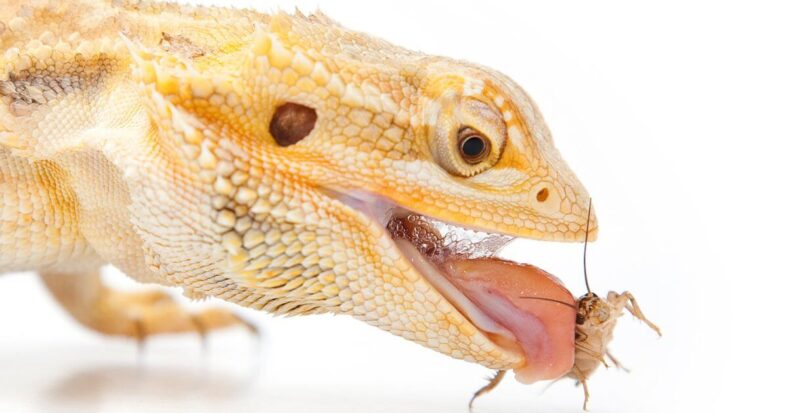
So, let’s dive in and explore what can bearded dragons eat.
From insects and live prey to vegetables and greens, I’ll share my insights on safe and nutritious Bearded Dragon Food options.
I’ll also discuss best practices for feeding, such as gut loading and dusting prey, portion sizes, and monitoring your bearded dragon’s diet and health.
What Can Bearded Dragons Eat
Understanding your bearded dragon’s nutritional needs is the foundation for its long-term health.
By the end of this guide, you’ll understand what bearded dragons can eat. How to create a balanced and nutritious diet plan that supports their growth and happiness.
1. Understanding the Bearded Dragon Diet
As a bearded dragon owner, I understand the importance of providing my pets with a balanced and nutritious diet.
This section will explore the key dietary components that make up a healthy bearded dragon diet. From protein sources to vegetables and greens, we’ll cover everything you need to know to ensure your bearded dragon gets the nutrition they need.
So, let’s dive into the world of bearded dragon nutrition and learn about the key dietary components that make up a balanced diet.
1.1. Importance of a Balanced Diet
A well-rounded diet is vital for your bearded dragon’s health, growth, and well-being. Providing a variety of nutritious foods can prevent common health issues and ensure your beardie thrives.
A proper diet will also support their immune system, helping them to live a long and healthy life.
In addition to preventing health problems, a balanced diet also promotes healthy skin, good digestion, and overall vitality. When your bearded dragon receives the right nutrients, you’ll notice they have more energy, better coloration, and an enhanced quality of life.
1.2. Key Dietary Components for Bearded Dragons
Bearded dragons are omnivores, meaning their diet should include a mix of protein sources, vegetables, and occasional fruits. Each food group provides essential nutrients contributing to your beardie’s health.
Insects and live prey offer protein crucial for growth and muscle development.
Vegetables and greens provide essential vitamins and minerals, while fruits serve as a treat and a source of additional vitamins.
Striking the right balance between these food groups is essential for a thriving bearded dragon.
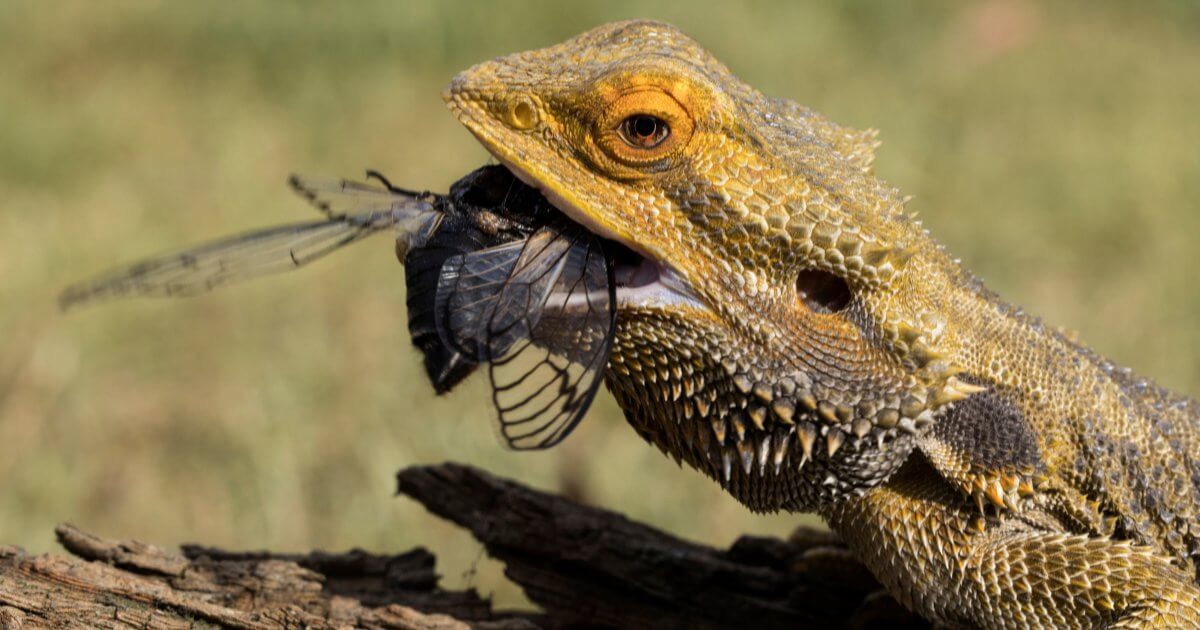
2. The Bearded Dragon Food List: Safe and Nutritious Options
The variety of foods available for bearded dragons might seem overwhelming at first. To simplify things, we’ve compiled a list of safe and nutritious options for your pet, broken down by category.
Insects and live prey are the main protein sources for bearded dragons. However, not all insects are equal when it comes to nutrition. It’s essential to offer your beardie a diverse and healthy selection of insects.
2.1. Insects and Live Prey
- Crickets
- Dubia roaches
- Mealworms (for adult dragons only)
- Superworms
- Waxworms (as occasional treats)
- Hornworms
- Silkworms
- Phoenix worms (a.k.a. black soldier fly larvae)
- Locusts (depending on your region)

2.2. Vegetables and Greens
In addition to insects, bearded dragons require a variety of vegetables and greens in their diet.
These provide essential vitamins, minerals, and fiber to keep your pet healthy.
When selecting vegetables and greens, high calcium-to-phosphorus ratios promote strong bones.
- Collard greens
- Mustard greens
- Turnip greens
- Dandelion greens
- Butternut squash
- Bell peppers
- Green beans
- Snap peas
- Escarole
- Parsley
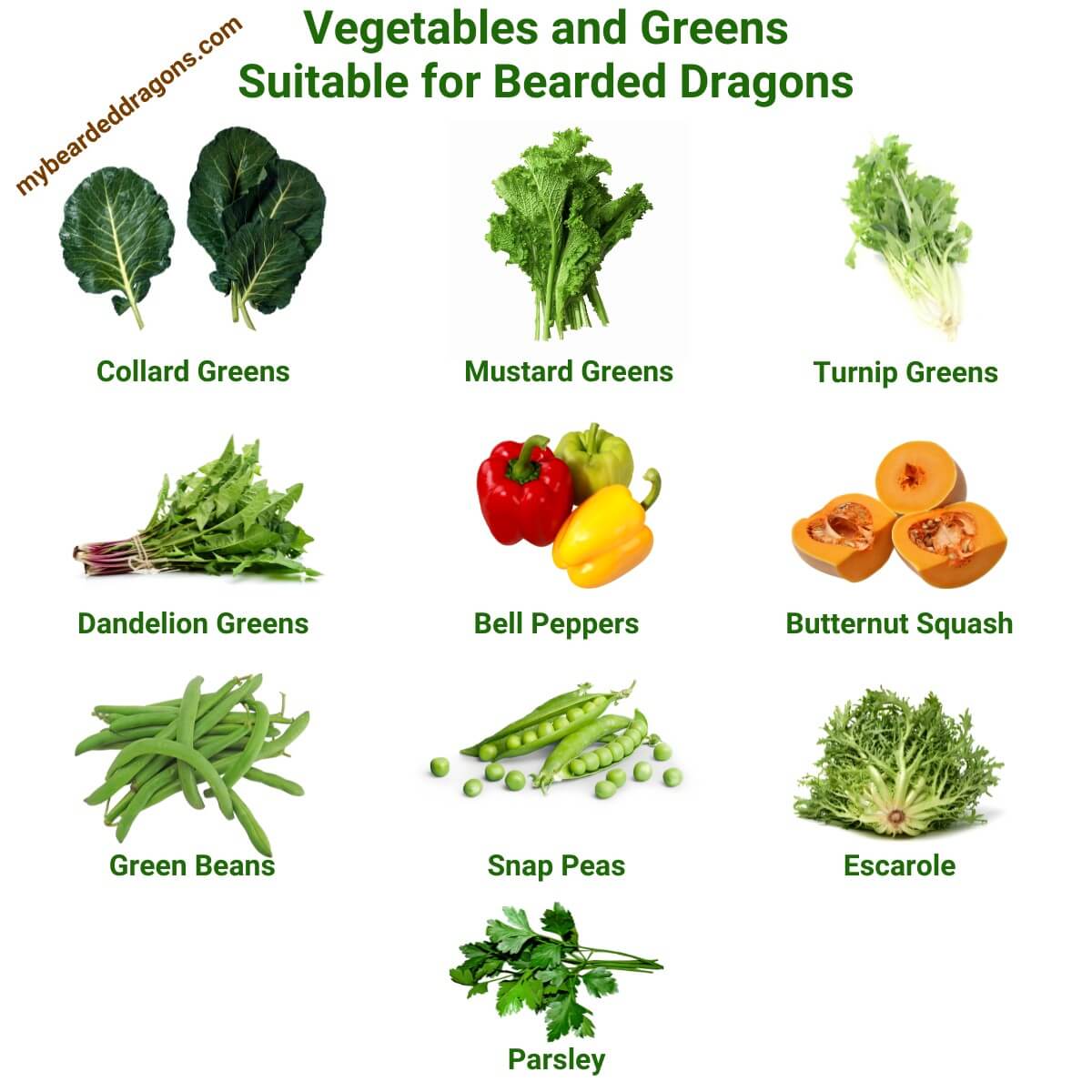
2.3. Fruits and Treats
Fruits should be offered to your bearded dragon sparingly, as they are high in sugar and can lead to health issues if fed in excess. When choosing fruits for your bearded dragon, prioritize those low in oxalates and high in nutritional value.
- Blueberries
- Raspberries
- Strawberries
- Mango
- Papaya
- Figs (fresh or dried)
- Dates (in moderation)
- Apple (peeled and seeds removed)
- Watermelon
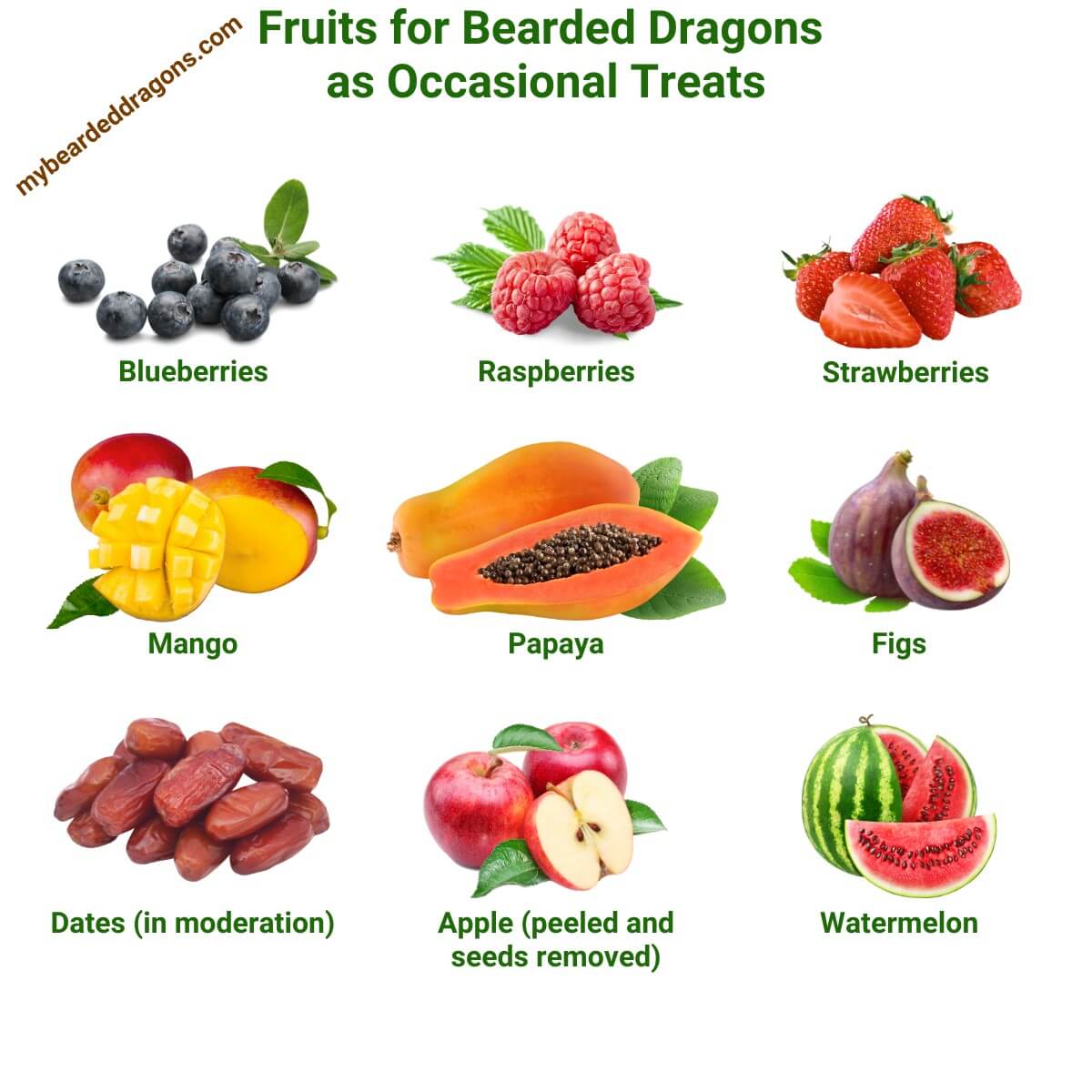
2.4. Unsafe and Toxic Foods to Avoid
Some foods are unsafe or toxic for bearded dragons and should be avoided. These can cause serious health problems or even be fatal. It’s crucial to be aware of these harmful foods and keep them out of your beardie’s diet.
- Avocado
- Rhubarb
- Wild-caught insects (due to potential pesticides or parasites)
- Spinach (binds calcium)
- Lettuce (low nutritional value)
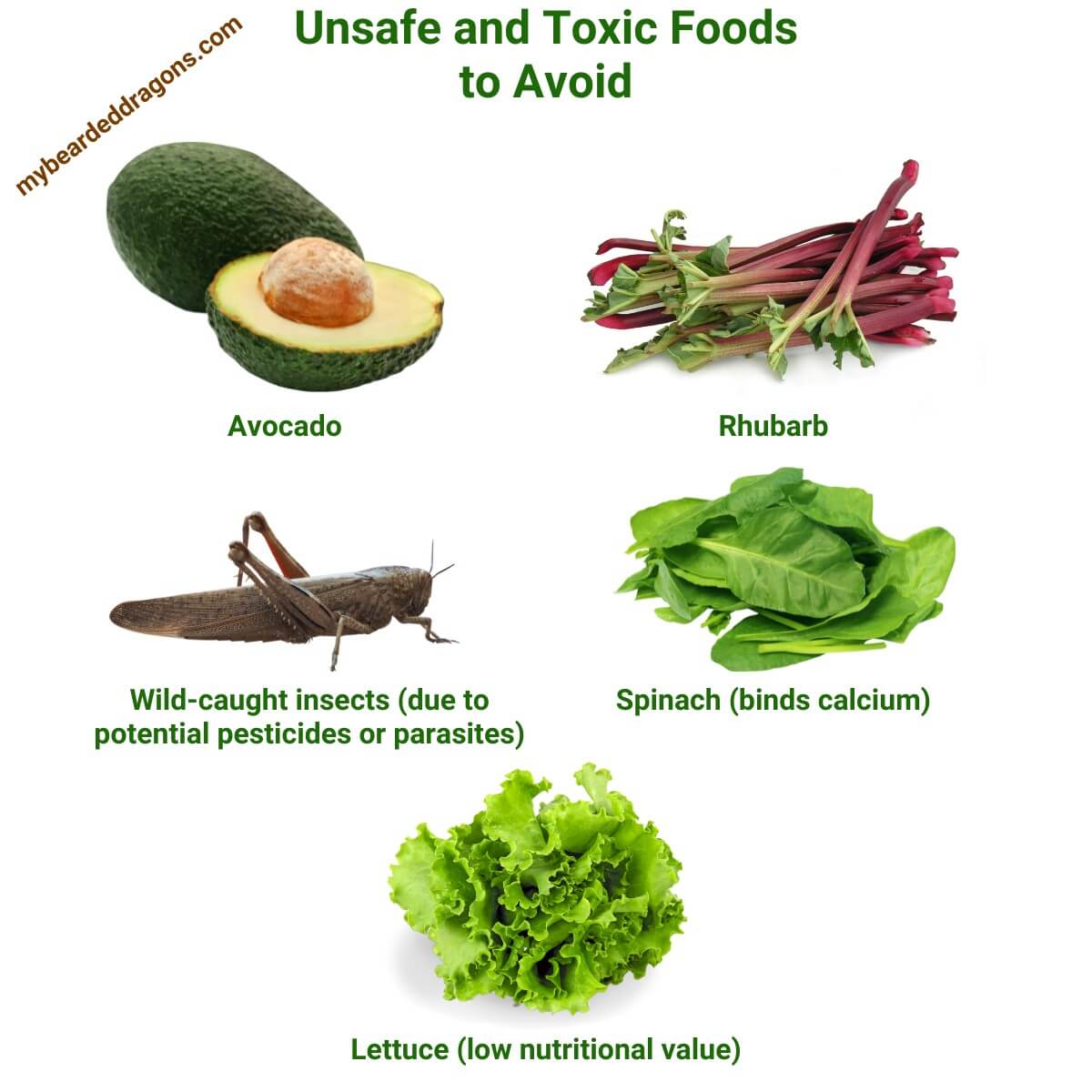
3. Bearded Dragon Food Chart: A Visual Guide to a Balanced Diet
We’ve created a visual guide to help you better understand the proportions of different food groups in your bearded dragon’s diet.
This food chart will serve as a handy reference when planning meals for your beardie, ensuring they receive a balanced and nutritious diet.
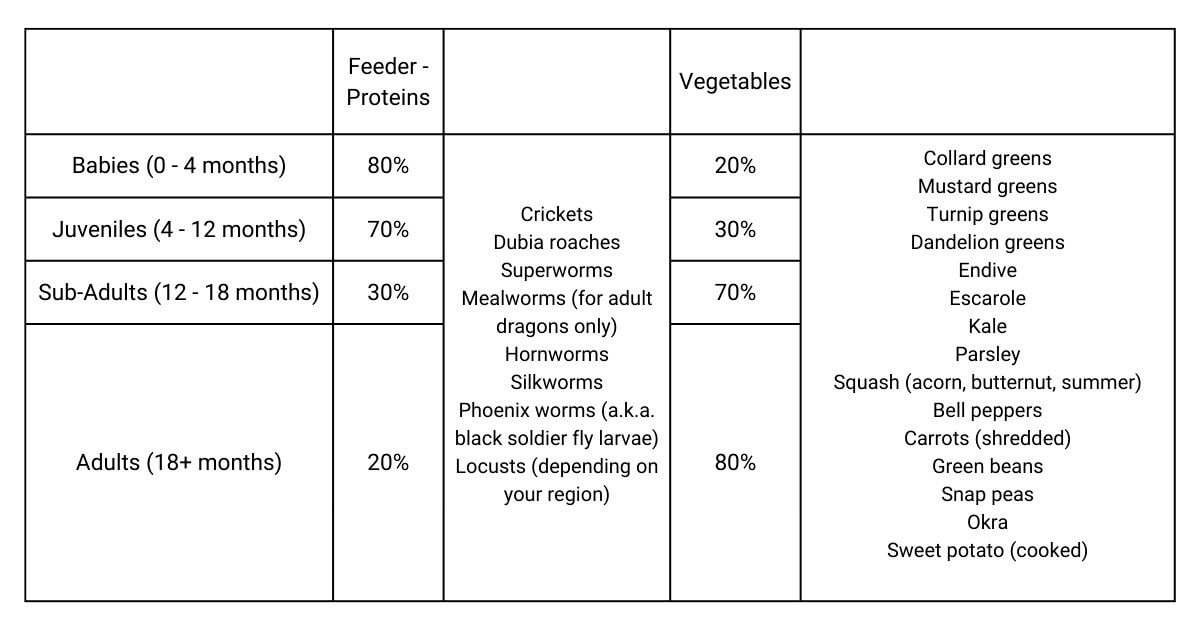
3.1. Protein Sources
Aim for a diet consisting of approximately 80% insects and live prey for baby bearded dragons, decreasing to about 40-50% for adults.
Always gut-load and dust the insects with calcium and multivitamin powders to enhance their nutritional value.
3.2. Vegetable and Green Options
Vegetables and greens should make up a significant portion of your bearded dragon’s diet.
For baby bearded dragons, this should be around 20%, while adult bearded dragons will need roughly 50-60% of their diet to consist of vegetables and greens.
3.3. Fruit Options and Treats
Fruits should be offered sparingly, as they are high in sugar. Generally, they should account for no more than 10% of your bearded dragon’s diet. Only feed them fruit as an occasional treat.
3.4. Toxic Foods to Avoid
Keep unsafe and toxic foods away from your bearded dragon. These items can be harmful or even fatal to your pet.
Familiarize yourself with the list of dangerous foods and ensure they are not included in your beardie’s diet.
4. Feeding Bearded Dragons: Tips and Best Practices
Providing a balanced diet is just one aspect of feeding your bearded dragon. Implementing the best practices and techniques for feeding can help ensure your pet’s overall health and well-being.
A helpful tip: Rotate the types of insects you offer to your bearded dragon and ensure they are from a trusted source to avoid potential pesticide exposure.
4.1. Gut Loading and Dusting Prey
Gut loading is the process of feeding insects a nutritious diet before offering them to your bearded dragon. This enhances the nutritional value of the insects, ensuring your beardie receives all the necessary nutrients.
Dusting prey involves further coating insects with calcium and vitamin supplements to improve their nutritional content.
This combination of gut loading and dusting is essential for preventing deficiencies and promoting optimal health.
4.2. Portion Sizes and Feeding Frequency
Monitor portion sizes and adjust feeding frequency based on your bearded dragon’s age, size, and activity level. Young bearded dragons require more frequent feedings with smaller portion sizes, while adults can be fed larger meals less often.
Overfeeding can lead to obesity and other health issues. It’s essential to find the right balance for your pet.
Here are some key points to keep in mind when it comes to portion sizes and feeding frequency:
- Young bearded dragons (up to six months old) should be fed 2-3 times daily, with smaller portions.
- Juvenile bearded dragons (six months to a year old) can be fed twice daily with slightly larger portions.
- Adult bearded dragons (over a year old) can be fed once a day with larger portions.
| Age Range | Feeding Frequency | Portion Size |
|---|---|---|
| Youg (up to 6 months) | 2-3 times daily | Small |
| Juvenile (6 months to 1 year) | Twice daily | Slightly larger |
| Adult (over 1 year) | Once daily | Larger |
Monitor your bearded dragon’s weight and adjust feeding frequency and portion sizes accordingly.
5. Age-Appropriate Diets: Feeding Bearded Dragons at Different Life Stages
As your bearded dragon grows and matures, their dietary needs will change. Adjusting their diet to accommodate these changes is crucial for maintaining their health and well-being.
5.1. Baby Bearded Dragon Diet
Baby bearded dragons require a diet that is high in protein to support their rapid growth.
Feed them appropriately sized insects multiple times a day, and offer a smaller portion of vegetables and greens. Monitor their growth and adjust their diet accordingly to ensure proper development.
5.2. Juvenile Bearded Dragon Diet
Juvenile bearded dragons still need a significant amount of protein but should gradually transition to a diet that includes more vegetables and greens.
Feed them insects daily, and increase the amount of vegetables and greens in their diet. Monitor their growth and make necessary adjustments as they continue to develop.
5.3. Adult Bearded Dragon Diet
Adult bearded dragons require fewer insects in their diet, with a greater emphasis on vegetables and greens.
Feed insects every other day, while offering a variety of vegetables and greens daily. Fruit should remain an occasional treat.
Keep an eye on your bearded dragon’s weight and overall health, and adjust their diet as needed.
6. Bearded Dragon Diet Supplements: Ensuring Optimal Health
Supplements play a critical role in maintaining the health of your bearded dragon. Providing the right supplements in the correct amounts is essential for preventing deficiencies and promoting overall well-being.
6.1. Calcium and Vitamin D3 Supplements
Calcium and vitamin D3 supplements are necessary for preventing metabolic bone disease, a common issue in bearded dragons.
Dust insects with calcium powder a few times a week and use a UVB light to support proper vitamin D3 synthesis.
6.2. Multivitamins for Bearded Dragons
Multivitamins help ensure your bearded dragon receives all the essential nutrients they need for optimal health. Dust insects with a multivitamin supplement once a week.
6.3. Proper Supplementation Schedule
Establish a supplementation schedule that works best for your bearded dragon, and consult a veterinarian if you’re unsure about the appropriate balance for your pet.
7. Conclusion on What can bearded dragons eat
Regular monitoring of your bearded dragon’s diet and health is crucial for maintaining their well-being. By providing a balanced diet and following best practices, you can help your pet thrive.
7.1. Importance of Regular Monitoring
Keep an eye on your bearded dragon’s eating habits, weight, and overall health. This allows you to make necessary adjustments to their diet and catch any potential health issues early on.
Regular veterinary check-ups are also essential for ensuring your bearded dragon stays in good health.
7.2. Adapting the Diet to Your Bearded Dragon’s Needs
Remember that every bearded dragon is unique, and their dietary needs may vary. Pay attention to your beardie’s preferences and make adjustments as needed.
If you're unsure about any aspect of your bearded dragon's diet or health, consult a reptile specialist or veterinarian for advice.
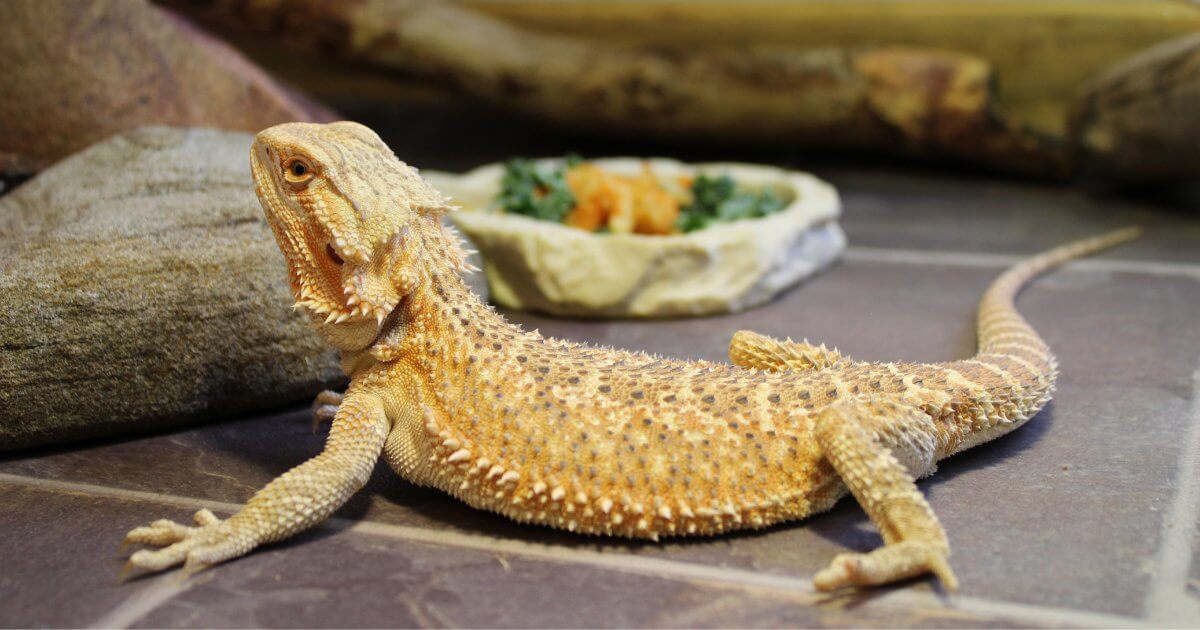
By following these guidelines and staying informed about your bearded dragon’s nutritional needs, you can create a diet that supports its growth, health, and well-being throughout life.
Frequent questions about what can bearded dragons eat
While bearded dragons can eat some human foods, it’s essential to be cautious and stick to safe options. Good options include squash, sweet potato, green beans, and bell peppers. Avoid feeding them high-fat and high-sugar foods, as well as processed foods.
Bearded dragons can have different preferences, but most of them enjoy insects such as crickets, dubia roaches, and mealworms. It’s important to offer a variety of protein sources and vegetables to ensure a balanced diet.
Bearded dragons can eat various vegetables daily, including collard greens, mustard greens, turnip greens, dandelion greens, and squash. It’s vital to avoid high-oxalate vegetables such as spinach and lettuce, as they can bind calcium and lead to health issues.
Fruits should be offered as occasional treats rather than daily staples, as they are high in sugar. Good fruit options for bearded dragons include berries, mango, and papaya.
